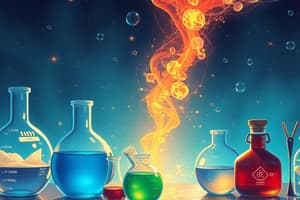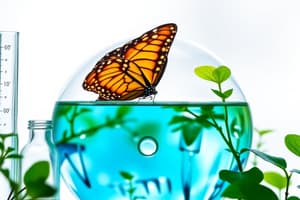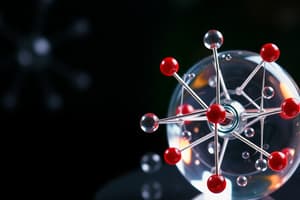Podcast
Questions and Answers
In DNA, adenine (A) pairs with ______, while guanine (G) pairs with cytosine (C).
In DNA, adenine (A) pairs with ______, while guanine (G) pairs with cytosine (C).
thymine
[Blank] fats contain no carbon-carbon double bonds and are typically solid at room temperature.
[Blank] fats contain no carbon-carbon double bonds and are typically solid at room temperature.
Saturated
The primary function of ______ is protein synthesis, translating mRNA into polypeptide chains.
The primary function of ______ is protein synthesis, translating mRNA into polypeptide chains.
ribosomes
The first law of thermodynamics states that energy cannot be created or destroyed, only ______.
The first law of thermodynamics states that energy cannot be created or destroyed, only ______.
[Blank] cells are characterized by the absence of a nucleus and other membrane-bound organelles.
[Blank] cells are characterized by the absence of a nucleus and other membrane-bound organelles.
The ______ is responsible for modifying, sorting, and packaging proteins and lipids for transport within a cell or secretion outside the cell.
The ______ is responsible for modifying, sorting, and packaging proteins and lipids for transport within a cell or secretion outside the cell.
Enzymes lower the ______ of a reaction, thereby increasing the reaction rate.
Enzymes lower the ______ of a reaction, thereby increasing the reaction rate.
The breakdown of glucose to generate energy occurs through a metabolic pathway called cellular ______.
The breakdown of glucose to generate energy occurs through a metabolic pathway called cellular ______.
The scientific method involves several steps; after formulating a hypothesis, the next crucial step is typically to design and conduct a controlled ______ to test that hypothesis.
The scientific method involves several steps; after formulating a hypothesis, the next crucial step is typically to design and conduct a controlled ______ to test that hypothesis.
In an experimental setup, the ______ variable is the one that the researcher manipulates, while the ______ variable is the one that is measured to see if it is affected.
In an experimental setup, the ______ variable is the one that the researcher manipulates, while the ______ variable is the one that is measured to see if it is affected.
The atomic ______ of an element is determined by the number of protons in its nucleus and dictates the element's identity and chemical properties.
The atomic ______ of an element is determined by the number of protons in its nucleus and dictates the element's identity and chemical properties.
Radioactive ______ are used in medicine for both diagnostic imaging and therapeutic treatments due to their ability to emit detectable radiation.
Radioactive ______ are used in medicine for both diagnostic imaging and therapeutic treatments due to their ability to emit detectable radiation.
In a ______ covalent bond, electrons are unequally shared between atoms, resulting in partial positive and negative charges on the atoms involved, as seen in a water molecule.
In a ______ covalent bond, electrons are unequally shared between atoms, resulting in partial positive and negative charges on the atoms involved, as seen in a water molecule.
[Blank] is a property of water that allows insects to walk on the surface of water, resulting from the cohesion of water molecules.
[Blank] is a property of water that allows insects to walk on the surface of water, resulting from the cohesion of water molecules.
A solution is considered acidic if it has a higher concentration of ______ ions ($H^+$) than hydroxide ions ($OH^-$).
A solution is considered acidic if it has a higher concentration of ______ ions ($H^+$) than hydroxide ions ($OH^-$).
The formation of a dipeptide from two amino acids involves a ______ reaction, where a molecule of water is removed to create a peptide bond.
The formation of a dipeptide from two amino acids involves a ______ reaction, where a molecule of water is removed to create a peptide bond.
Flashcards
Glucose
Glucose
Monosaccharide used for energy; a primary source of energy for cells.
Homeostasis
Homeostasis
Maintaining a stable internal environment despite external changes.
Hypothesis
Hypothesis
A testable explanation for a phenomenon.
Sucrose
Sucrose
Signup and view all the flashcards
Independent Variable
Independent Variable
Signup and view all the flashcards
Glycogen
Glycogen
Signup and view all the flashcards
Starch
Starch
Signup and view all the flashcards
Proton
Proton
Signup and view all the flashcards
Cellulose
Cellulose
Signup and view all the flashcards
Atomic Number
Atomic Number
Signup and view all the flashcards
Ion
Ion
Signup and view all the flashcards
Chitin
Chitin
Signup and view all the flashcards
Nonpolar Covalent Bond
Nonpolar Covalent Bond
Signup and view all the flashcards
Eukaryotic Cells
Eukaryotic Cells
Signup and view all the flashcards
Polymer
Polymer
Signup and view all the flashcards
Energy
Energy
Signup and view all the flashcards
Study Notes
- Exam 1 includes multiple-choice, true/false, and matching questions.
Scientific Study of Life
- Understand all the characteristics that define life and recognize examples of homeostasis.
- Know the order of the scientific method steps: make a hypothesis, identify variables, create a theory, and set up a control experiment.
- Differentiate between independent and dependent variables in an experiment
- Understand the levels of complexity in living organisms, ordered from atoms to the biosphere.
- Distinguish between a cell, tissue, organ, organ system, and organism.
The Chemistry of Life
-
Be familiar with the subatomic particles of an atom: protons, electrons, and neutrons.
-
Understand electron roles and orbitals, knowing that electrons determine an atom's properties.
-
Differentiate between atomic number (number of protons) and atomic weight (number of protons plus neutrons).
- For instance, an atom with 8 protons, 8 electrons, and 7 neutrons has an atomic number of 8 and an atomic weight of 15.
-
Know the definitions of ions and isotopes.
- Understand how radioactive isotopes are applied in medicine and dating fossils.
-
Different types of chemical bonds exist including ionic, covalent (polar and nonpolar sharing), and hydrogen bonds.
- Sodium chloride exemplifies ionic bonding.
-
Differentiate between polar and non-polar molecules.
- Water is a polar molecule.
-
Understand the terms hydrophilic and hydrophobic.
-
Know the properties of water.
-
Understand the pH scale: acidic, basic, and neutral.
- Relate acidity and basicity to hydrogen (H+) and hydroxide (OH-) ion concentrations.
-
Differentiate hydrolysis and dehydration reactions.
-
Understand macromolecules (polymers) and their components (monomers).
- Proteins are polymers of amino acids.
- Recognize amino acid structure (variable R group, conserved carboxyl and amino groups).
-
Nucleic acids are composed of nucleotide subunits.
-
Understand what a peptide bond is.
-
Know the carbohydrates glucose, sucrose, glycogen, starch, cellulose, and chitin
- Know their roles in energy storage and structural support.
- Chitin and cellulose have structural roles in cells and organisms.
-
Differentiate saturated and unsaturated fats and recognize examples of lipids like phospholipids and steroids.
-
Understand the different levels of protein structure: primary, secondary, tertiary, and quaternary.
-
Differentiate between DNA and RNA.
-
Know their respective roles in the cell.
-
Understand the base pairing rules in DNA (A-T, G-C) and RNA (A-U, G-C).
-
Be capable of finding a complementary sequence for a given sequence.
Cell
- Differentiate prokaryotic and eukaryotic cells.
- Compare the organelles in bacteria, plant, and animal cells.
- Examples of organelles include the nucleus, mitochondria, chloroplast, cell wall, lysosomes, endoplasmic reticulum, ribosome, cilia, flagella, microtubules, centrioles, and chromosomes.
- Know the function of all the organelles.
- Differentiate smooth and rough endoplasmic reticulum by both structure and function.
- The "roughness" is due to the presence of ribosomes, which are responsible for protein synthesis.
- Study Cytoplasmic movement (cyclosis).
- Know that the major component of the cell membrane is phospholipids.
- The cell membrane also contains proteins.
- Understand the functions of proteins in the cell membrane.
- Define what the fluid mosaic model refers to in the context of cell structure.
The Energy of Life
-
Differentiate potential and kinetic energy with examples.
- Sugars and fats possess potential energy.
-
Define metabolism.
-
Understand the laws of thermodynamics.
- Be able to explain the difference between the first and second laws.
-
Explain what ATP is in terms of its structure and its function.
-
Understand that enzymes are catalysts.
- Understand how they function in terms of activation energy.
-
Differentiate between the active site and substrate of an enzyme.
-
Understand feedback inhibition (competitive and non-competitive).
-
Know factors (pH and temperature) affecting enzyme action.
-
Know coenzymes, such as NAD.
-
Explain cellular transport systems: osmosis, diffusion, facilitated diffusion, active transport, endocytosis, exocytosis, pinocytosis, and phagocytosis.
- Know specific examples of each transport system.
- The sodium-potassium pump participates in active transport.
- Engulfing bacteria represents phagocytosis.
-
Differentiate between isotonic, hypertonic, and hypotonic environments and their effects on cells.
- Adding red blood cells to water prompts swelling, because water is hypotonic to the cells.
- A 10% salt solution represents a hypertonic environment.
Studying That Suits You
Use AI to generate personalized quizzes and flashcards to suit your learning preferences.




